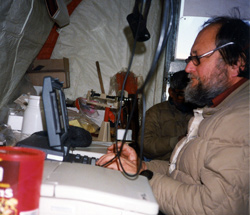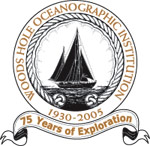This is an archived site. This site is no longer being maintained or reviewed for broken links.
Employee Portrait Gallery—Jim Doutt
 |
|
|
Jim Doutt went to the Arctic for month-long experiments in May 1989, June 1990, and March 1992 near 75°N on Canadian ice. Here he works at a laptop computer in the ARTEX92 science tent during one of the several-day cold (to -40°F) and windy (40-knot) periods that occurred during this deployment. Jim’s father lived and worked in Arctic igloos 50 years before to conduct research on northern mammals. (Photo by Cindy Sellers)
|
Jim Doutt followed a family tradition of working in science. His father was curator of mammalogy at the Carnegie Museum of Natural History in Pittsburgh, and his mother a botanist. Jim was introduced to Woods Hole on visits to his uncle, Herb Graham, who was director of the Fisheries lab here. While a student at Penn State, Jim supported a summer on Cape Cod as a member of the MBL housekeeping staff. Another summer at WHOI with Brackett Hersey’s geophysics group in 1962 proved prophetic: most of Jim’s career has been devoted to working with sound waves in seawater and in the seafloor.
Following completion of work for a master’s degree in geology at Caltech, Jim joined the WHOI staff as a research assistant in 1965. He first worked with Carl Bowin aboard Chain tending the gravity meter on a Caribbean cruise and then with the Hersey group on a ray trace computer program to determine how sound travels through an ocean with layers having different sound speeds.
Jim took a leave of absence in 1972 to spend four years at the NATO SACLANT Research Centre in La Spezia, Italy. While there, he participated in studies of the “deep scattering layer,” acoustic reflections from the swim bladders of schools of fishes, which plagued naval personnel looking for submarines. Jim says helping to understand the variations in the amount of sound reflected at different frequencies as these animals moved from deeper, more compressive waters to shallower levels was a career highlight for him.
Upon returning to Woods Hole in 1976, Jim continued to pursue his interests in underwater acoustics, signal processing, application of microcomputers to acquisition and processing of acoustic signals, and use of the Global Positioning System for sub-meter-accuracy range determination at sea. Dick Nowak, who often built equipment to collect data analyzed on computers that Jim programmed, said, “We’d have some lively arguments about whether it was my equipment or his programming that caused the latest glitch, but I can’t think of anybody I’d rather work with than Jim. He was always meticulous in his treatment of the data and the programming.”
One project with Subramaniam Rajan took him to the far north three times with a small team to study the detailed structure of Arctic ice and its seasonal change using the acoustic technique known as tomography.
After more than 30 years of applying his expertise to a wide variety of WHOI projects, Jim retired in 2003, but he continues his interest in Institution work, along with pursuing a lifelong love of observing nature while hiking and sailing.
[back]

